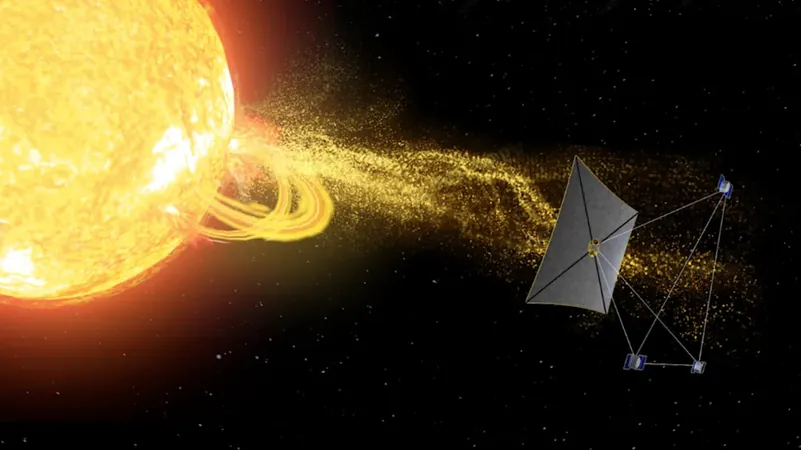
Revolutionary Solar Sail Spacecraft Set to Warn Us of Dangerous Space Weather Threats
2025-07-11
Author: Liam
The Growing Threat of Space Weather
In today's tech-driven world, the vulnerabilities posed by space weather loom large over our reliance on electric grids, aviation, and telecommunications. Space weather refers to the various changes in the space environment, driven largely by solar activity, that can have profound impacts on Earth.
What is Space Weather?
One significant type of space weather includes interplanetary coronal mass ejections (CMEs), which are massive bursts of solar wind and magnetic fields soaring at astonishing speeds of over 1,200 miles per second. While these events can create stunning auroras, like the northern lights, they can also wreak havoc on satellites, disrupt electric grids, and expose astronauts to hazardous radiation during missions to the Moon and Mars.
The Dangers Are Real
As investments in space exploration multiply—ranging from satellite networks to lunar resource extraction—the risk of severe space weather becomes increasingly urgent. Current estimates suggest that space weather could threaten up to $2.7 trillion in global assets. Historical events such as the 1859 Carrington event, which supercharged telegraph systems and sparked fires across North America and Europe, underscore the potential devastation.
Current Monitoring Systems Might Not Be Enough
Currently, space weather monitoring relies on satellites that observe solar winds from proximity to Earth. Many are positioned in low Earth orbit and geosynchronous orbits, effectively shielded by Earth's magnetic field. However, during extreme space weather events, this magnetic shield can weaken, potentially allowing harmful solar particles to enter our atmosphere.
The Need for Better Warnings
Gladly, innovations are on the horizon. Expanding the warning time for imminent solar events beyond the current threshold of 40 minutes could be game-changing for astronauts, satellite operators, and even airlines. More advanced notice would allow satellite operators to perform critical maneuvers during geomagnetic storms, preventing satellite loss, and enabling airlines to divert flights to minimize passenger exposure to radiation.
Introducing SWIFT: A New Era in Space Weather Monitoring
In a breakthrough development, a group of experts led by heliophysicist Mojtaba Akhavan-Tafti is working on the Space Weather Investigation Frontier (SWIFT)—a next-generation satellite constellation. Notably, one satellite will operate at a groundbreaking distance of 1.3 million miles from Earth, offering up to 60 minutes’ warning for incoming solar threats.
Harnessing the Power of Solar Sails
SWIFT will incorporate an innovative solar sail technology, providing it the ability to soar where traditional propulsion methods falter. Unlike previous satellites that require constant fuel, this solar sail will utilize light from the sun to propel itself through space, enabling prolonged missions in an otherwise challenging orbit.
The Future of Space Monitoring
The ambitious plans include launching the Solar Cruiser, equipped with a sail area larger than a football field, as early as 2029. If successful, this mission will set the stage for a network of four SWIFT satellites, ensuring comprehensive monitoring of solar winds and offering critical data to enhance space weather predictions.
Why This Matters
As our reliance on space-based technologies intensifies, investing in advanced space weather prediction systems is crucial. With SWIFT on the horizon, we are on the brink of reshaping our ability to prepare for—and perhaps mitigate—the dangerous effects of space weather, safeguarding our technological landscape.









 Brasil (PT)
Brasil (PT)
 Canada (EN)
Canada (EN)
 Chile (ES)
Chile (ES)
 Česko (CS)
Česko (CS)
 대한민국 (KO)
대한민국 (KO)
 España (ES)
España (ES)
 France (FR)
France (FR)
 Hong Kong (EN)
Hong Kong (EN)
 Italia (IT)
Italia (IT)
 日本 (JA)
日本 (JA)
 Magyarország (HU)
Magyarország (HU)
 Norge (NO)
Norge (NO)
 Polska (PL)
Polska (PL)
 Schweiz (DE)
Schweiz (DE)
 Singapore (EN)
Singapore (EN)
 Sverige (SV)
Sverige (SV)
 Suomi (FI)
Suomi (FI)
 Türkiye (TR)
Türkiye (TR)
 الإمارات العربية المتحدة (AR)
الإمارات العربية المتحدة (AR)